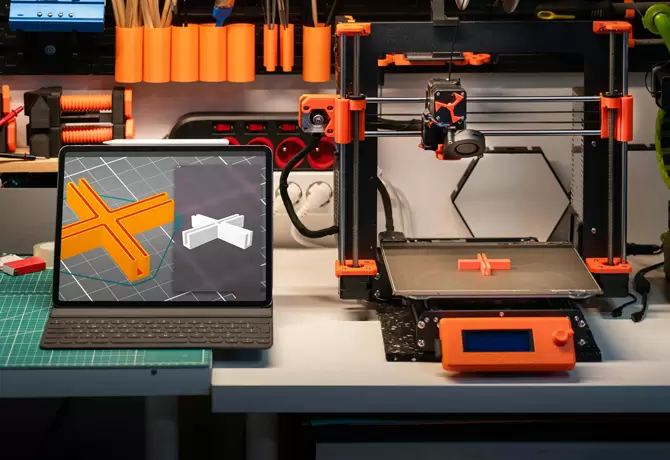 Home / Resources / Blog Articles / Harnessing the Power of FDM Prototypes in Modern Equipment Parts Manufacturing
Home / Resources / Blog Articles / Harnessing the Power of FDM Prototypes in Modern Equipment Parts Manufacturing April 11, 2025
April 11, 2025
In the modern manufacturing landscape, rapid prototyping has become a key component in the design and production process. The introduction of technologies like Fused Deposition Modeling (FDM) has revolutionized the way prototypes are developed, enabling faster, more efficient, and cost-effective production of equipment and parts. FDM prototypes play a crucial role in various industries, offering manufacturers a streamlined approach to create accurate and functional prototypes before moving to full-scale production.

Fused Deposition Modeling (FDM) is a popular additive manufacturing technique that has significantly impacted the prototyping process across many sectors. Unlike traditional manufacturing methods that involve subtracting material from a larger block, FDM works by adding material layer by layer to build a 3D object. This method offers several advantages, including reduced material waste, increased design flexibility, and the ability to create complex geometries that would be difficult or impossible to achieve through conventional manufacturing techniques. The key to the success of FDM prototypes in the manufacturing of equipment parts lies in the versatility of the FDM technology itself. With FDM, manufacturers can quickly develop functional prototypes made from a variety of materials, which makes it easier to test the fit, form, and function of parts before committing to full production. This helps mitigate the risk of costly mistakes and ensures that products meet the required specifications.
One of the primary benefits of using FDM prototypes in the equipment parts manufacturing industry is the reduction in cost and lead time. Traditional prototyping methods often involve expensive molds, tooling, and extensive manual labor. FDM, on the other hand, does not require such intricate tooling. Once a 3D model is designed, the prototype can be printed directly from the digital file, significantly reducing both material costs and production time. This cost-effectiveness is particularly beneficial for companies in the early stages of product development, as it allows them to test multiple design iterations without having to invest heavily in tooling and equipment. Additionally, since FDM prototypes can be produced rapidly, the design and testing cycles can be completed much faster, allowing for quicker time-to-market.
Another advantage of FDM prototypes in equipment parts manufacturing is the high level of design flexibility they offer. Traditional manufacturing processes are often limited by the complexity of the design, particularly when dealing with intricate geometries or tight tolerances. However, FDM technology allows for the creation of highly complex shapes and structures, including internal features like channels or cavities that would be difficult or impossible to achieve using conventional methods. This level of design freedom enables engineers and designers to explore a wider range of possibilities in their designs, which can lead to innovations that would have been difficult to realize with traditional manufacturing techniques. Furthermore, the ability to rapidly produce and test these complex designs means that manufacturers can refine their products more effectively, ensuring the final design is optimized for performance and functionality.
FDM technology supports a wide range of materials, which makes it suitable for producing prototypes of equipment parts with varying functional requirements. From basic thermoplastics to high-performance materials like ABS, polycarbonate, and nylon, FDM prototypes can be created using materials that mimic the properties of the final product. This allows manufacturers to test prototypes under conditions that closely replicate the intended use of the product. Moreover, FDM prototypes can be customized to meet specific requirements, such as varying levels of strength, flexibility, or heat resistance. This customization is particularly useful in industries where parts must be designed to withstand harsh environmental conditions or specific functional demands. By testing prototypes made from different materials, manufacturers can ensure they select the best option for the final production run.
The iterative nature of the FDM prototyping process allows for continuous refinement of equipment part designs. Unlike traditional manufacturing, where making design changes can be costly and time-consuming, FDM prototypes can be easily modified by adjusting the digital model and printing a new version of the part. This iterative process encourages frequent testing and adjustments, which ultimately leads to better-designed products. Additionally, the ability to produce multiple prototypes in a short period allows manufacturers to experiment with different design variations, optimizing both functionality and aesthetic appeal. This is particularly valuable in industries where product innovation is a key driver of success, such as consumer electronics, automotive, and aerospace.
FDM prototypes significantly reduce lead time in the prototyping phase, allowing manufacturers to bring products to market faster. Traditional prototyping methods, such as injection molding or CNC machining, can require weeks or even months to set up the necessary tooling and machines. With FDM, however, a prototype can be printed in just a matter of hours, enabling companies to move quickly from concept to physical product. This reduction in lead time also allows for faster design validation and testing, ensuring that the product meets all performance criteria before full-scale production begins. By shortening the prototyping phase, manufacturers can avoid delays and costly mistakes that may arise later in the production process.
The use of FDM prototypes in the equipment parts manufacturing industry has brought about significant improvements in cost-efficiency, design flexibility, and speed. By leveraging this technology, manufacturers can reduce prototyping costs, accelerate the development process, and produce functional parts that meet stringent quality standards. Whether in automotive, aerospace, medical devices, or consumer electronics, FDM prototypes are an invaluable tool in the product development cycle. As the technology continues to evolve, it is likely that FDM will become even more integral to the way that equipment and parts are designed and manufactured, enabling companies to bring innovative, high-quality products to market faster than ever before.